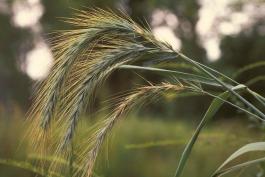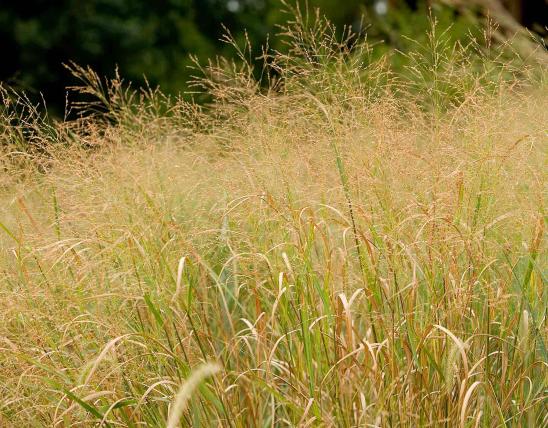
Missouri has about 276 species in the grass family, including well-known crop plants and our native prairie grasses. Distinguishing between the species can be difficult, but it’s easy to learn some basics about the group.
Grasses are annual or perennial plants with linear, parallel-veined, 2-ranked leaves whose lower portions sheath the stems (culms). The sheaths are often open (split) and have ligules (a membrane or group of hairs where the leaf blade joins the stem). Stems are round in cross-section, and hollow except at the nodes (joints where new leaves or branches arise). Flowers lack sepals and obvious petals; instead they are enclosed by scale-like glumes, lemmas, and paleas. Florets (individual flowers) are grouped into spikelets, which can grow in spikes, racemes, panicles, and other arrangements. Each fruit is a grain (caryopsis).
Similar species: Plants in the sedge family usually have 3-sided, solid stems, 3-ranked leaves, closed sheaths, flowers with scales at the base, and nutlike fruits (achenes). Plants in the rush family have round but solid stems, basal leaves, closed sheaths, flowers with similar-looking sepals and petals, and many-seeded capsules that are round in cross-section.
Height: some species are only a few inches high, while others, such as big bluestem, corn, and bamboo, reach 8 feet or more.

Statewide. Some species are fairly widespread and common. Others are rare or limited to certain habitats or parts of the state.
Habitat and Conservation
There are only about 10,000 species of grasses globally, but grasses cover a huge amount of landmass worldwide. They are the most widespread plant family. Many are weedy annuals (meaning that they get established quickly in disturbed areas), so they are some of the first plants to colonize barren landscapes. Some are invasive and threaten established native plant communities. Some have specific habitat requirements and are endangered. When humans started cultivating certain grasses and stayed near their farms, it was the beginning of cities and civilization.
Status
Although the number of species in the grass family trails that of several other plant families, if you counted individual plants, grasses will easily win the numbers game.
Grasses are by far the most economically important family of plants in the world. Grasses are the “staff of life” for almost every human; rice, corn, wheat, barley, oats, and rye are all grasses. Those can all be fermented into alcoholic beverages, too. Sugarcane, sorghum, and corn are made into sweeteners.
Life Cycle
Grasses differ by life cycle, growth habit, and the seasonal peak growing time.
As with other nonwoody plants, some grass species are annual (reseeding themselves each year, with individual plants dying each winter) and others are perennial (individual plants surviving for more than one year).
Growth habit is a major distinction among grasses:
- Sod-forming grasses, or turf grasses, form new plants on horizontal stems (rhizomes or stolons) much as iris or strawberry plants do. They spread horizontally across or just under the ground, forming an intermeshed, matlike colony. They’re popular in lawns and pastures. Examples of sod-forming grasses include Kentucky bluegrass, prairie cordgrass, Johnson grass, tall fescue, Indian grass, big bluestem, buffalo grass, Bermuda grass, and zoysia.
- Bunchgrasses form tufts or clumps, as new plants (tillers) form right beside the parent plant, the new stems growing upward instead of outward. Examples include perennial ryegrass, orchard grass, little bluestem, prairie dropseed, eastern gama grass, blue and hairy grama, poverty grass, and Timothy.
Grasses are separated into two groups based on their peak growing time. Whether a grass is "cool-season" or "warm-season" is based on the species' chemical and metabolic pathways for most efficiently conducting photosynthesis.
- Cool-season grasses grow most efficiently in fairly cool, moist environments, usually blooming in spring, going dormant midsummer, and growing rapidly fall–winter. Examples include Kentucky bluegrass, perennial ryegrass, Canada and Virginia wild ryes, river oats, bottlebrush grass, orchard grass, tall fescue, and poverty grass. These grasses green up quickly in spring but tend to dry up during our hottest months.
- Warm-season grasses grow most rapidly and are greenest in the brightest, hottest, driest months. Examples include big bluestem, Indian grass, prairie cordgrass, little bluestem, prairie dropseed, switchgrass, eastern gama grass, blue and hairy grama, buffalo grass, Bermuda grass, and zoysia. These are typically greenest in July and August, when the cool-season grasses usually dry up.
Human Connections
In addition to feeding humanity (they are our staple crops worldwide), grasses are fodder for domestic animals. They provide materials for building shelters, tools, and more (think of bamboo chopsticks and fishing poles, thatching, sod houses, mats, paper, insulation, and basketry). Turf and ornamental grasses are important, too.
Ecosystem Connections
Grasses are the heart of grasslands, literally defining their landscapes, including Missouri’s tallgrass prairies. Multitudes of animals and plants live in grasslands worldwide. Grazing mammals need grasses. Grasses bind and protect soil, preventing erosion. The 1930s Dust Bowl occurred after grasses had been stripped from the land.









































































